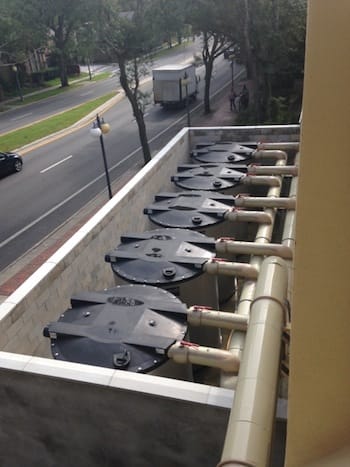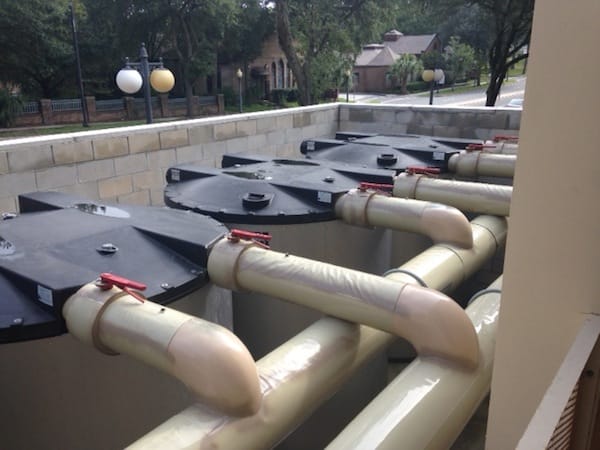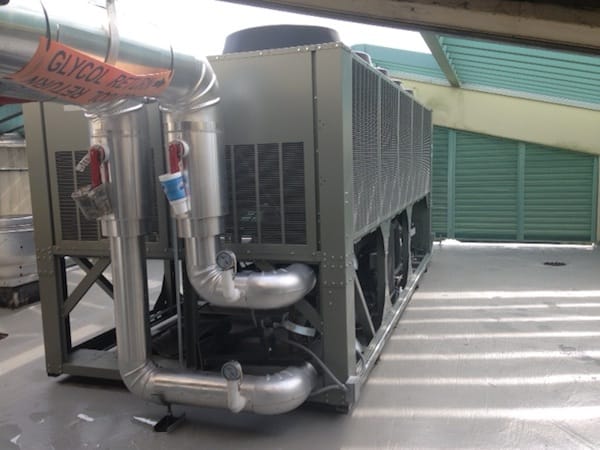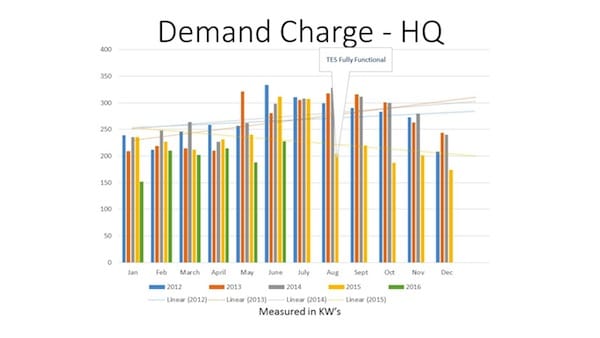The Alachua County Library Headquarters, built in 1992, is the central administrative location for the Alachua County Library District (ACLD), an independent special taxing district and the sole public library services provider for Alachua County’s nearly 250,000 residents. From its 80,000 square foot headquarters in downtown Gainesville, just outside the University of Florida, the district oversees 11 other branch locations in municipalities throughout the county, a storefront library in collaboration with the Partnership for Strong Families in northeast Gainesville, two bookmobiles, multiple deposit collection sites and a library service to inmates of the Alachua County Jail. Each of these resources operate as part of the district’s overall goal to provide every citizen of Alachua County with free, open and equal access to education, information and entertainment.
It is important for ACLD to spend taxpayer funds wisely in order to sustain its many activities and best serve patrons. This means making sure operating costs are minimized whenever possible. Energy is a significant expense for the ACLD, second only to labor. Gainesville Regional Utilities (GRU) supplies the ACLD and deploys some of the highest energy rates in the state of Florida during the day.
In most areas of the country, nighttime energy can be as much as is 50 percent less expensive than daytime energy. This is true whether a building is using time-of-use energy, which is a variable rate structure that charges for energy depending on the time of day, or what is considered a flat rate, which means pricing is fixed and remains the same regardless of when it’s used. Flat rate users still see this spike in daytime pricing due to demand tariffs, which are common on most all utility bills. These fees are levied on the peak demand which usually occurs during the day when demand for energy is at its highest, making the price of daytime energy significantly more than nighttime energy.
 The ACLD is currently on a time-of-use rate price structure; however, a reduction in demand charges presented the biggest opportunity for savings. GRU implements a demand charge that equates to roughly $9.25 in extra fees for each kW used during peak demand hours. So ACLD’s utility bill consists of a time of use charged billed in kWh plus a demand charge billed in kW. In order to save big, ACLD would need to use energy when it was least expensive.
The ACLD is currently on a time-of-use rate price structure; however, a reduction in demand charges presented the biggest opportunity for savings. GRU implements a demand charge that equates to roughly $9.25 in extra fees for each kW used during peak demand hours. So ACLD’s utility bill consists of a time of use charged billed in kWh plus a demand charge billed in kW. In order to save big, ACLD would need to use energy when it was least expensive.
ACLD knew that operating costs was an area that could benefit from improvement and began to explore the implementation of energy-efficient technologies. The district looked to address the low-hanging fruit, or the areas that could easily be improved before making larger or more invasive changes. The district decided to focus on its headquarters and use that building to test the success of various energy savings initiatives, such as a lighting upgrade and a cost effective chiller change out to replace the antiquated air-conditioning system.
After reading about the benefits of thermal energy storage for cooling buildings in a highly respected trade journal, Dan Whitcraft, CFM, the district’s Facilities & Safety Services Administrator, reached out to another thermal energy storage customer and received recommendations for CALMAC IceBank energy storage and a referral to Matern Engineering, a Florida-based engineering firm with 20+ years of experience designing ice storage systems. GRU was brought into the process right from the start of the project in September 2014 and worked with the library to conduct a feasibility study based on actual utility rates for a 12-month period.
Analysis showed that energy charges are 68 percent less expensive at night due to GRU’s pricing structure and chiller demand costs could be slashed by 100kW if load shifting technology would be used to reduce peak demand. This means that, in terms of costs, when electricity is used is just, if not more important than how much is used. Based on this study and the fact that it was time for chiller replacement, it was determined that the ACLD headquarters would be a prime candidate for ice-based energy storage and implementation of the system would be mutually beneficial for both utility and customer. If successful, the technology could reduce the burden on GRU’s power grid during times of high capacity, thus limiting the chances of demand exceeding supply. GRU became invested in the installation, intending to use it as a pilot before bringing in other large customers. With the results in favor of a load shifting technology, Whitcraft concluded that thermal energy storage was the obvious technology choice, as it is a load-shifting technology that can reduce the amount of energy being consumed during peak demand hours.
Whitcraft addressed the Library Director and proposed using this chiller replacement as an opportunity to save tax payer dollars by implementing CALMAC’s thermal energy storage system to shift the library’s peak energy usage from daytime “peak” hours to nighttime “off-peak” hours. CALMAC’s system creates cooling in the form of ice overnight using less expensive energy and stores it in the IceBank® energy storage tanks. The ice can then be melted for use during peak demand hours the next day. In addition to adding the thermal energy storage system, the library also made changes to its lighting. Originally, it used metal halide bay lighting which generated a lot of heat within the building. The use of this lighting meant that the HVAC system had to work even harder to cool the building. By switching to induction lighting, the library was able to reduce the lighting load by 50 percent and reduce part of the burden being placed on the HVAC system.
Results
Energy costs savings
The decision to implement an energy storage system, paired with a smaller and more efficient chillers, proved extremely effective, even without a rebate program. Using approximately 125kW of CALMAC’s eight foot by eight foot energy storage tanks, the library is able to capitalize on significantly less expensive night-time energy, which costs $0.023 per kWh, as opposed to creating instantaneous cooling during the day that could cost as much as $0.072 per kWh. That’s a 68 percent savings just by using thermal energy storage! Additionally, with thermal storage, monthly demand (kW) could be slashed in half. That’s up to 50% off in demand charge savings by just using thermal storage! This is a significant figure since 40 percent of the headquarters’ total electric costs for the year can be directly attributed to cooling the structure, which is open seven days a week.
Flexible operation
CALMAC’s ice-storage system is paired with four different modes of operation through the structure’s Building Automation System (BAS): chiller only, ice only, combination and free cooling. The chiller only mode makes the system act as a traditional system where instantaneous cooling is created by the chiller. The ice only mode relies purely on cooling that was created and stored the previous night. Combination mode enables the building to use both stored cooling and the chiller simultaneously to meet the day’s cooling demands. Throughout the colder months, the free cooling mode can utilize outdoor air to chill the water used in the air conditioning system in place of a chiller.
“We have complete control and flexibility over how and when the ice is used,” said Dan. “The tanks complete the charging processes at 5:50 a.m. and begin to come online at 6:30 a.m. During the hot summer months, the melting ice is able to handle 70 percent of the day’s cooling load with the chiller handling the remaining 30 percent. We expect to only use ice, meaning no chiller, to cool the building during the winter months when outdoor temperatures are lower.”
Other benefits
The building upgrades also offered numerous benefits for the library when considering life cycle costs. The use of energy-efficient, less heat-intensive lighting allowed the library to reduce its chiller capacity from 195 tons to 150 tons. While the addition of ice-based energy storage brought the chiller size down further to 130 tons. Operational cost savings generated from the energy upgrades including more energy efficient lighting, a new more energy efficient chiller and thermal energy storage tanks are expected to be around $40,000 on an annual basis and the district is confident that, given these predictions, it will be able to pay back the cost of installing its thermal storage tanks in less than two years. CALMAC’s tanks have a life expectancy of 40 years and require minimal upkeep, making them a prudent investment that can provide savings which far outweigh their costs.
Both ACLD and GRU have been extremely pleased with results and have provided tours of the installation to nearby universities and other large energy users. The library district’s staff has also been supportive, with the district’s director, Shaney Livingston, even considering implementation of CALMAC’s system at additional locations within the library’s branch system.
Through the support and cooperation of its local utility, the library headquarters was able to successfully reduce peak demand. The energy cost-saving initiatives put in place by ACLD have enabled it to realize significant savings in terms of peak energy consumption and reduction in demand charges. ACLD is proof of the impact that an energy storage system can have on utility bills and now serves as an example to other area businesses looking to realize similar savings.
“It is encouraging to see the level of interest that the Alachua County Library District headquarters has received from other nearby businesses,” said Mark MacCracken, CEO of CALMAC. “Ice-based energy storage is the low-hanging fruit in energy cost reductions that can pay enormous dividends. Once you understand the price difference in day and night electricity, the strategy becomes simple. ACLD is now able to decouple when they make cooling from when they need cooling, giving them the ability to capitalize on this cheaper nighttime energy.”
Sidebar- Where the demand savings come from
A common misconception is that if a building is not offered a Time of Use (TOU) pricing by the utility, then they are on a “flat rate”, implying that there is no difference between day and night costs. This is not the case, since demand tariffs are common on a utility bill. Typically, when demand charges are converted to daytime energy usage, electricity costs are about half the cost during nighttime hours, even when you are not offered a time of day rate. For example, if energy costs are “flat” at $0.040/kWh both day and night but demand costs are $9.25/kW the effective daytime energy costs are $0.096/kWh during the day because of demand charges for a daytime peaking building.
Calculate: Impact of demand charges on electric bill
Let’s do a back of the envelope calculation on a 1,000 ton system to see what the demand contribution to the energy charge works out to be.
Daytime Cooling Costs
Demand Charge/month
1,000 tons x 0.8 kW/ton=800 kW
800 kW x $9.25=$7,400/month
Energy usage for chiller for month
1,000 tons x 10Hrs x75% (diversity) 0.8 kW/tonx22 days per month=132,000 kWh
Approximate Cost for Demand converted to kWh
$7,400 per month night demand/132,000kWh per month=$ 0.056/kWh
Daytime energy costs for running the chiller /kWh=$ 0.040/kWh + $ 0.056/kWh = $ 0.096/kWh
Daytime cooling cost per ton-hour = $ 0.096/kWh x 0.8 kW/ton=$ 0.0768
Nighttime Cooling Costs
Demand Charge/month
Buildings with comfort cooling peak during the day, so demand charges do not contribute to nighttime cooling costs.
Nighttime energy costs for running the chiller /kWh=$ 0.040/kWh + $0.00 kWh (demand contribution) = $ 0.040/kWh
Nighttime cooling put into storage cost per ton-hour =$0.040/kWh x 0.8 kW/ton = $ 0.032
To summarize, during the night, the cost to store cooling will be about 3 cents per ton-hour, while during the day a ton-hour costs closer to 8 cents to generate. So a flat all day energy charge of $0.040 / kWh, day and night, combined with a peak daytime demand charge of $9.25/kW can be a great rate for storage. In this example, creating cooling at night is almost 62 percent less expensive







Join the conversation: